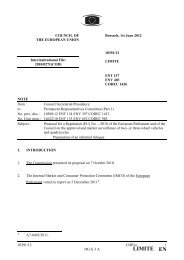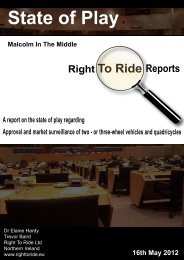MoToRcyclE RoAD SAFETy REpoRT 2010 - Dekra
MoToRcyclE RoAD SAFETy REpoRT 2010 - Dekra
MoToRcyclE RoAD SAFETy REpoRT 2010 - Dekra
Create successful ePaper yourself
Turn your PDF publications into a flip-book with our unique Google optimized e-Paper software.
Vehicle safetya simulation study carried out by DEKRAAccident Research on the basis of 87 welldocument motorcycle accidents. The scientistsundertaking the research showedthat, if the motorcycles had been fittedwith an ABS 25 up to 35% of the accidentsanalysed would have been prevented.The perfect technical solution wouldhave been a combination of ABS with anintegral brake and a technical assistedbraking system, which is currently still inthe development phase. This would haveprevented almost twice as many accidents(50% to 60%), as such systems react muchmore quickly than conventional brakingsystems in dangerous situations.The background to this is that, in dangeroussituations, motorcyclists often donot exploit breaking performance to thefull, fearing that this will lock the frontwheel, and so settle for a braking distanceextended by a few crucial metres. In suchsituations, ABS and modern combinationbraking systems, which optimally distributethe braking force between front andrear wheel, could demonstrate their fullpotential, especially on wet roads. Thanksto ABS, deceleration values of up to 8 m/s²and more can now be achieved, even onwet roads (Figure 32). ABS stabiles braking,reduces braking distance and inhibitsoverbraking at the front wheel, therebyWith the BMWC1, the rider isprotected by anenveloping yokestructure.preventing falls during braking. ABS alsoreduces the strain placed on the motorcyclistduring braking, especially in crisissituations and emergencies.The Allianz Zentrum für Technik(AZT) (Allianz Centre for Technology)worked intensively on ABS, analysing200 particularly serious motorcycle accidents.Approximately 90 accidents werefiltered out as being of relevance to ABS,as they clearly exhibited braking in the“pre-crash” phase. It was found that ABSrelevantcases increased by 69% in nonbuiltup areas. The majority of opposingvehicles were passenger cars and tractors(59% and 13% respectively).POSITIVE COST-BENEFITANALYSIS FOR ABSOf the 90 ABS-relevant cases, adequatedocumentation on the length of the skidmark, the length of the scratch mark andpossible other traces was available in 48




